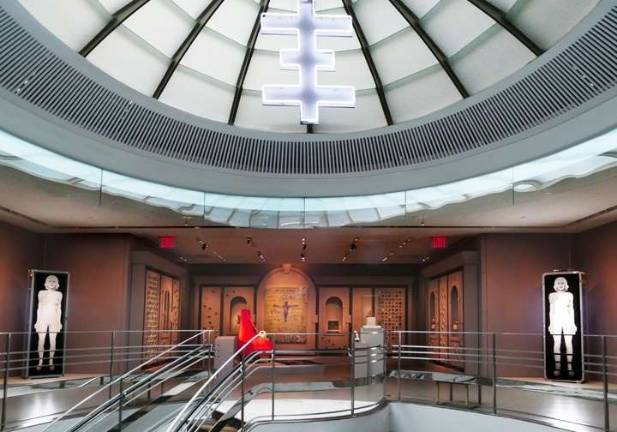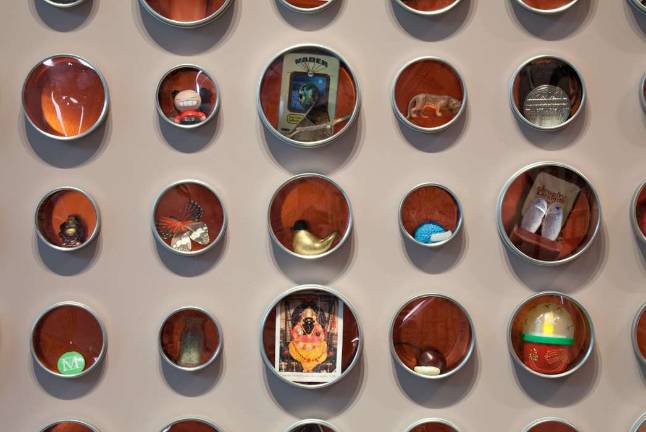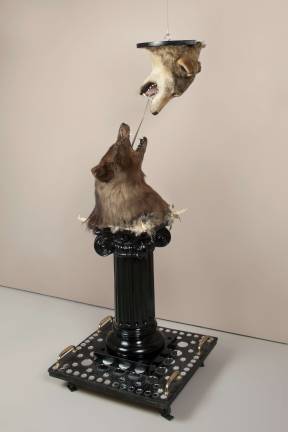Altering the self and the world



BY DONATHAN SALKALN
High up inside the Rubin Museum of Art, just under the atrium’s skylight, is a love nest of two people who became one. Both are naked.
Each had undergone years of cosmetic and other procedures as part of Genesis Breyer P-Orridge’s so-called “Pandrogeny Project,” a twin attempt by Breyer P-Orridge and Breyer P-Orridge’s wife, Lady Jaye Breyer P-Orridge, to join as a single being. Each underwent breast augmentation surgery, nose, lip and facial reconstruction, hormone treatments and tattooing, to look and feel alike. The images glow as bright white-light. In the background are black caskets.
Above the atrium’s well hangs a psychic cross and at far center is an image of Breyer P-Orridge’s crucifixion, similar in perspective to Salvador Dali’s “Christ of Saint John of the Cross.”
Breyer P-Orridge has lived and worked in Nepal’s Kathmandu Valley on several occasions during the last three decades. The exhibition, titled “Try to Altar Everything, 2016,” looks at how Hindu mythology and Kathmandu Valley have influenced the Breyer P-Orridge and h/er art.
The exhibit’s title, “Try to Altar Everything, 2016,” of course denotes “altar” – where the two united in marriage — but also plays on “alter,” as in change — and Breyer P-Orridge’s life work of rebelling against conventional thinking and ideals.
“I’ve been involved in a total war with culture since the day I started,” s/he once said. “I am at war with the status quo of society and I am at war with those in control and power. I’m at war with hypocrisy and lies, I’m at war with the mass media.” Breyer P-Orridge has always fought the system and in the Rubin’s exhibit, s/he goes the distance in rebelling against nature’s own DNA, combining the genetic traits of two into one.
Breyer P-Orridge’s artwork is displayed in large arched-shaped wall recesses.
You’re likely to find a favorite piece and also to be appalled by another, as Breyer P-Orridge’s art strikes at the core of conventional thought. Besides the overwhelming entrance, these are my favorite moments:
“Begging Bin-Eshe, 2012:” A large version of a Nepalese beggar’s silver bowl that, when looking into it, echoes sentiments one might have when looking up at the Sistine Chapel’s ceiling. In it are cut up and rearranged images of both Genesis and Lady Jaye with multiple arms, a reference to Hindu deities, laid on an image of sky. Much of the show’s art contains similar cut-up photo collages, as Genesis has been heavily influenced by William Boroughs’ cut-ups: slicing texts at random and arbitrarily rearranging them.
“It’s All A Matter Of Time:” A chance find of a small grandfather clock is an especially poignant piece. Inside, hanging alongside the clocks weights, is an early Polaroid of Lady Jaye, who died in 2007. The piece includes a shining chrome egg, symbolic of birth. Below rests a prehistoric fossil tooth, possibly representing Darwinism and evolution. The piece addresses life’s brevity, and, with its mirrored clock face, includes the viewer.
“Tongue Kiss:” The heads of two wolves facing each other, one above and one below, with long daggers projecting from their mouths, signify mankind’s more primal instincts. The piece is made all the more dramatic by a harsh lighting casting long shadows against the wall. The beauty in the beasts is that as the top wolf head spins in space, the shadows of the daggers touch, connecting the two heads.